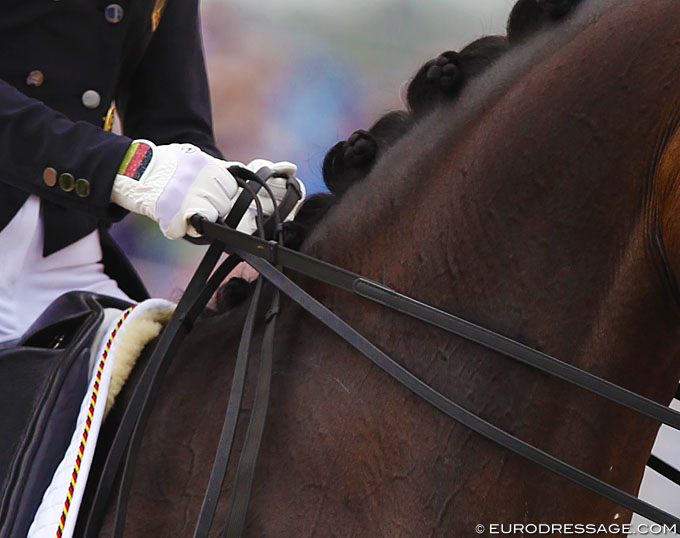I’ve ridden Western and English. My horse as a kid ended up very light in Western and could do all kinds of things.
Dressage reaching to the bit, then overtime learning to lift and collect, then learning to do extensions in collection, is just an entirely different balance than a good Western horse.
I don’t know why horses seek the snaffle bit, but they do. I do know that horses seem to enjoy doing collection/lengthening and moving in that balanced way.
I also rode my first horse English. We could do some lateral work, and once we did three tempes at the canter. I bought a reprint of a cavalry manual and puzzled over The Indirect Rein of Opposition and other dressage mysteries. But I had no instruction and was never sure what contact would mean. One day I was riding home at a brisk walk and pony stretched to the bit and kept contact and I thought that might be it (I was right) but had no idea how to replicate that moment. I thought my horses neck was too thick to get her nose on the vertical, therefore she would never be “collected” but now I know all the sliding stops and rollbacks and pivots we did showed wonderful collection in a different context.
Anyhow, dressage and English riding is more forward in orientation than Western. When contact is working, it’s a mutually accepted connection. You don’t necessarily need or want the split second agility of a good working Western horse and you won’t get it from most warmbloods anyhow. You want a lot of impulsion for both dressage and jumping. For dressage the big test is the extended trot which is an entirely developed gait. Obviously horses approach it more or less at liberty but it is not something you get on a green horse. And it’s glorious. Even mediums are glorious. The horse lifts her back and skims over the ground just a bit faster than really seems safe or prudent. Likewise in jumping, when your coach says “now that’s a canter you can really do something with,” you are secretly feeling it’s a full out gallop and you’re about to slam into the arena wall and wipe out 
In other words, English riding is more about harnessing impulsion to go in a straight line (or a circle) and the lateral movements in dressage are all about moving forward like shoulder in and half pass and even canter pirouette. Yes, you can open a gate on a dressage horse, and back up, etc. But we aren’t after the sudden stops and turns. I’m not sure that reining and dressage are compatible on the same horse. There might of course be the outlier that does both, but they aren’t compatible like jumping and dressage on the same horse that asks for a related kind of impulsion. Horses will likely be better at one than the other, but ideally in eventing they support each other and develop related skills.
Now in Iberian world, you do get Working Equitation that is a 3 phase of dressage, handy obstacle course slow and speed trials, and working cattle. That’s the closest I can think to blending what we call Western and English. But first, Iberian horses are very different from both WB and QH, think bullfighting horse. And second, even in the obstacle speed trials and cattle work, they are ridden more like dressage, more on the bit. They don’t do sliding stops, and certainly not on a loose rein, they do more what I think of as “pop stops.”
Anyhow, working equitation aside, both dressage and jumping are about moderating balance in a highly impulsive forward gait. When we are working correctly I use the reins to ask for balance and bend (whether lateral or vertical) and my seat)thighs for direction. My mare is a bit lazy but when I put the effort in to warm up correctly and do our collected/medium transitions it can come together in a wonderful way where riding her like that gives her impulsion and puffs her up. None of this came easy, and she will never have a huge extended trot. But when it’s working it’s about forward and when you are forward like that, you are not balanced to suddenly change direction. Canter pirouette comes out of a collected canter and a half pass, and you need to set the horse up for that in advance or it won’t happen (my mare isnt there, did this on schoolmaster a few years back). This is totally different from bombing down the football field at the high school, sitting down in the saddle and leaving ten foot skid marks in the turf, then rolling around to bomb back to some bemused or intimidated boys. So while Western is about signal, English is more about moderating balance in forward. You see this also in jumpers where the rider is balancing the horse between jumps, collecting then letting the horse carry himself to the fence. In jumpers you can ideally moderate a horse to make a given distance between poles in say 4 5 or 6 strides. It’s a controlled canter that goes between collected and almost hand gallop, but always balanced and somewhat upright. Like dressage, where extended trot is basically taking the body position of collected trot and adding impulsion. Collect on the short side, wheeee!!! down the long side while keeping the same balance.
Because you need so much real forward impulsion to do these things, the horse is not expected to be listening for a cue to change direction or halt in the middle of the exercise. You down shift gradually. You want the horse thinking forward ahead and you use that to modulate his balance. They know that contact doesn’t mean halt in your tracks in the middle of a jump course or dressage session.



